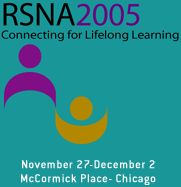
Abstract Archives of the RSNA, 2005
SSE22-01
A Quantitative Analysis of Computed Tomography (CT) Scanner Utilization in an Academic Medical Center with a Root Cause Analysis of Scanner Idle Time
Scientific Papers
Presented on November 28, 2005
Presented as part of SSE22: Health Services, Policy, and Research (Practice Management)
 Trainee Research Prize - Medical Student
Trainee Research Prize - Medical Student
Amichai J Erdfarb BA, Presenter: Nothing to Disclose
Howard Paul Forman MD, Abstract Co-Author: Nothing to Disclose
Irena Tocino MD, Abstract Co-Author: Nothing to Disclose
To quantify CT scanner utilization and productivity in an academic hospital setting and determine the primary causes of idle time.
2 scanners were observed for a total of 202 scanner-hours. Scanner time was divided into two main components: "in use" and "idle" time. In use time was further divided into prep, scan, and take down times. Independent variables recorded include in- vs outpatient, IV contrast (IVC) vs non-IVC, and scanner type. After performing a root cause analysis, primary contributors to idle time were identified in six main categories: preventative maintenance (PM), technical failure, upgrades, calibration, understaffing, and poor flow management (FLWM).
Total "in use" time was 62:09:00 (30.75%). Average hourly weekday utilization was 20:56 min/hour (34.89%). Scanner utilization peaked from 4-5 pm at 35:45/hr (59.08%), and reached a minimum value of 3:10/hr (5.27%) between 11 pm and midnight. Total weekday idle time was 115:59:30 categorized as follows: FLWM 90:45:18 (78.24%), understaffing 10:54:17 (9.40%), technical failure 10:12:40 (8.80%), calibration 2:15:00 (1.94%), PM 1:01:15 (0.88%), and upgrades 0:51:00 (0.73%). 218 complete and 7 partial CT studies were observed on 225 patients. Average door-to-door exam time was 12:38 (n 218, SD 7:16) compared to a standard appointment block of 30 minutes. Component times were "prep" 4:58 (n 218, SD 3:53), "scan" 5:08 (n 224, SD 3:33), and "take down" 2:36 (n 225, SD 1:47). Contrast exams took longer than non-contrast exams with average total exam times of 17:05 (n 104, SD 7:21) and 8:34 (n 114, SD 4:09) respectively. Scanner type and in/outpatient status of the examinee did not significantly effect total study times, all four of these groups having average total exam times of 12-13 minutes. Average inpatient transport time was 44:09 (n 67, SD 19:16).
There is considerable under-utilization associated with the present operation of the CT scanners, primarily resulting from poor patient flow management. Implementing new scheduling processes, modifying appointment block lengths, and more effectively managing inpatient flow and scanner idle time, has the potential to significantly increase patient throughput.
Erdfarb, A,
Forman, H,
Tocino, I,
A Quantitative Analysis of Computed Tomography (CT) Scanner Utilization in an Academic Medical Center with a Root Cause Analysis of Scanner Idle Time. Radiological Society of North America 2005 Scientific Assembly and Annual Meeting, November 27 - December 2, 2005 ,Chicago IL.
http://archive.rsna.org/2005/4407929.html


 Trainee Research Prize - Medical Student
Trainee Research Prize - Medical Student